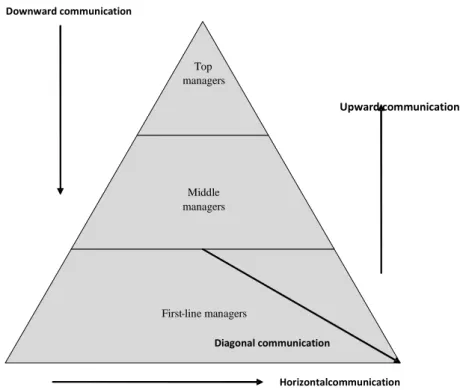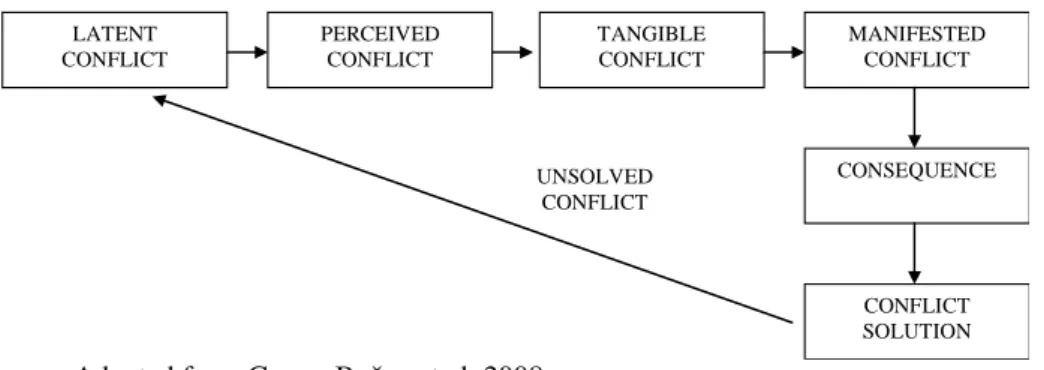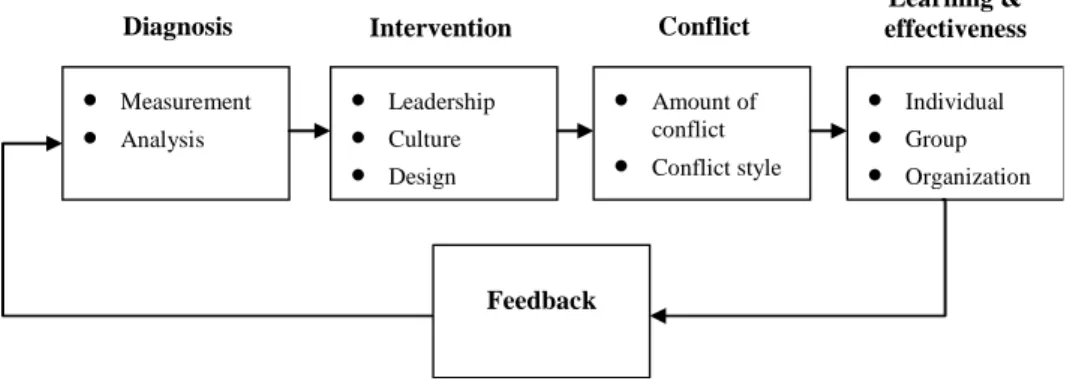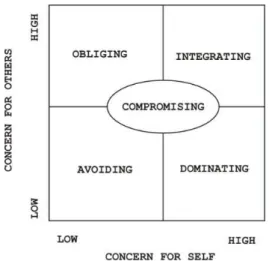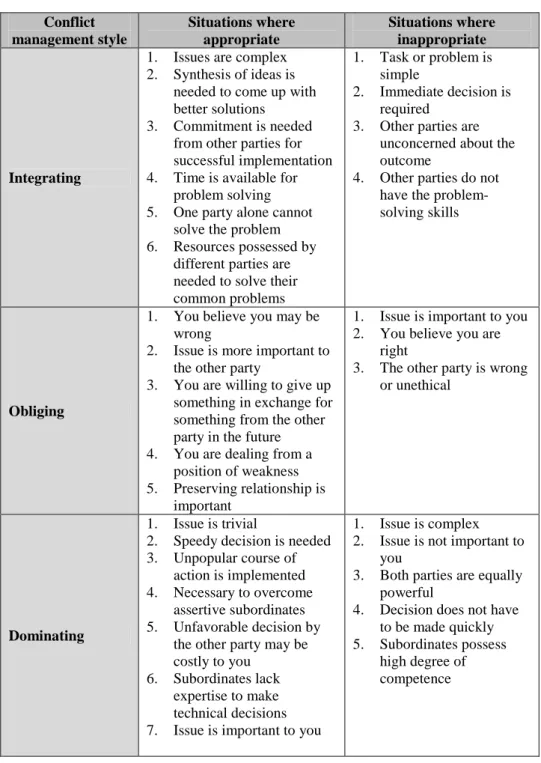103 ORGANIZATIONAL COMMUNICATION AND CONFLICT
MANAGEMENT
Kenan Spaho*
Received: 22. 2. 2013. Professional paper
Accepted: 7. 3. 2013. UDC: 65.01:316.65
No mistakes will be made by saying that without good internal communication there is no good external communication, which will then result in inadequate performance. In addition, it is not possible to imagine organizational communication without conflict. Conflicts are something normal in any organization because people have different opinions and among them, there are people who cannot accept other people’s different opinions. It was first believed that conflicts were something that might destroy manager’s authority but studies in the 1970s showed that conflicts could have a positive, as well as a negative side. There is a common agreement that it is very dangerous for an organization to have both too many conflicts, as well as not to have any conflicts. For the purpose of this paper, conflict management is analyzed as a contemporary field of management, while managers are analyzed in terms of their role in conflict management.
1. INTRODUCTION
In business world, communication is necessary for conducting business in an efficient manner. Any business involves two types of communication: external communication that is directed to the actors in the business environment, and internal communication or organizational communication that is directed to employees.
In addition, it is not possible to imagine organizational communication without conflicts. Conflicts are normal in any organization, because people have different opinions, while some individuals cannot accept other people’s
*
Kenan Spaho, MSc, Energoinvest d.d. Sarajevo, Hamdije Čemerlića 2, 71000, Sarajevo, Bosnia
different opinions. It is dangerous for an organization to have too many conflicts, as well as not to have any conflicts at all. For the purpose of this paper, we will focus on conflict management as a field, as well on managers and their role in the conflict management.
1.1.Organizational communication and conflict management – literature review
It is not possible to have good human relations without communication. An effective communication is required, not only for maintaining human relations, but also for achieving good business performance. In addition, practical experience shows that there is no communication without conflicts. Sometimes, conflicts can be useful, as they help to make correct decision, although they might represent a huge obstacle to an organization and its business. Firstly, some theoretical aspects of organizational communication will be presented, which is followed by discussion of selected theoretical aspects of conflicts and conflict management.
1.2.Organizational communication
Communication is transfer of information from sender to receiver, implying that the receiver understands the message. Communication is also sending and receiving of messages by means of symbols. In this context, organizational communication is a key element of organizational climate (Drenth et al, 1998). Finally, organizational communication is the process by which individuals stimulate meaning in the minds of other individuals by means of verbal or nonverbal messages (Richmond et al, 2005).
For efficient communication, it is necessary that the receiver understands the meaning of the message and indicates it to the sender through some expected reactions (Ivancevich, Matteson, 2002). Each organization must enable communication in several directions: downward communication, upward communication, horizontal communication, and diagonal communication, as illustrated by Figure 1 (Miljković, Rijavec, 2008).
Downward communication flows from top management to employees. This type of communication is characteristic for companies with an authoritative style of management.
Upward communication flows from employees to top management. The main task of this communication is to inform top management of the situation
on the lower levels. It is the best way for top management to analyze the efficiency of downward communication and organizational communication in general (Miljković, Rijavec, 2008).
Figure 1. Types of organizational communication
Top managers
Middle managers
First-line managers
Diagonal communication
Horizontal communication Downward communication
Source: Author
Horizontal communication flows between employees and departments, which are on the same organizational level. It enables coordination and integration of activities of departments, engaged in relatively independent tasks (Miljković, Rijavec, 2008).
Diagonal communication flows between people, which are not on the same organizational level and are not in a direct relationship in the organizational hierarchy. This type of communication is rarely used – usually in situations when it supplements other types of communication (Miljković,
Rijavec, 2008). Diagonal communication is used, e.g. as labor unions organize direct meetings between employees and top management, avoiding the first line and middle level managers.
1.3.Definition of conflict in an organization
Many factors prevent employees from direct and open communication - the result is a high risk of conflict situations. If the managers apply direct communication on time, the conflict can be avoided, or its impact can be minimized. Conflicts happen each day and their successful management is a key element of organizational and managerial success. Finally, conflict is a fact of our lives and if we are able to understand it and its impact on work effectiveness, we can make conflict useful and use them to achieve better results.
There are several definitions of conflict. Conflict is a process of social interaction and a social situation, where interests and activities of participants (individuals or groups) actually, or apparently, confront, block and disable the realization of one party’s objectives (Jambrek, Penić, 2008, 1199). In addition,
conflict is a process where person A deliberately makes an effort to prevent efforts of person B with an opposing action, which will result in frustrating Person B to achieve his goals or satisfy his interests (Robbins, 1995). Organizational conflict occurs, as actors engage in activities that are incompatible with those of colleagues within their network, members of other organizations, or unaffiliated individuals who utilize the services or products of the organization (Rahim, 2002). The same author conceptualizes conflict as an interactive process manifested in incompatibility, disagreement, or dissonance within or between social entities (individual groups, organizations, etc). There are several approaches to types of organizational conflicts but for our analysis we will take a look at the following types (Hener, 2010):
• Vertical conflicts occur because the supervisor is always telling an employee what to do and tries to ‘micro-manage’, while/although he/she should let the employee to do his/her job. This type of conflict exists in organizations where the organizational structure has a high degree of formality;
• Horizontal conflicts occur between employees within the same department, i.e. on the same hierarchical level. These conflicts can manifest themselves for many reasons, such as the different interests/ideas related to distribution of resources;
• Line Staff conflicts occur between support staff and line employees, within a department or an organization;
• Role conflicts can stem from an incomplete or otherwise fallacious understanding of the assignment given to an employee at a specific moment in time.
There are two types of conflict cases: personal and organizational (Petković et al, 2008). Personal causes come from personal characters when
people interact. Personal causes can be summarized in the next four groups (Petković et al, 2008):
• Bad estimation of a person. Conflicts often happen because of bad perception of the other side. The sides in conflict are not objective and understand the behavior of opposite side, as they wish to hurt the other side and its interests.
• Errors in communication. These errors come from people’s inability to listen to each other. In addition, errors come from information lost in upward and downward communication, due to inadequate understanding, or from one’s emotional status in the moment of communication.
• Distrust among people in the organization. Trust is the foundation of good interpersonal relations, as it develops and consolidates the system of values and confidence to each other. Five dimensions are important for developing trust in an organization: integrity, competence, consistency, loyalty, and openness. Distrust and suspiciousness create a good foundation for a potential conflict.
• Personal characteristics. Some people start conflict, because of their personal disliking. When people with completely different personalities need to work together, conflict cannot be avoided.
Organizational causes of conflict are consequence of the characteristics of organizational design, limited resources and characteristics of organizational systems, such as: compensations, decision-making, planning and budgeting (Petković et al, 2008). Some aspects of organizational causes of conflict are
(Petković et al, 2008):
• Dependence in work activities. When a member of an organization cannot start his/her job, since another member has not finished his/her job, or if an individual significantly influences a colleague’s job, then this might cause conflict.
• Differentiation of organizational units and incompatibility of operating goals. The specialization of organizational units (manufacturing, purchasing, finance, sales, etc.) manifests in everyday work as differences in working manners, goals and culture. These differences, as well as difference in their operative goals create a potential for emergence of horizontal conflict.
• Sharing limited resources. Resources in an organization are related to of power and influence, with each department trying to obtain a larger share. These resources are not only financial, but are also related to
information technology, human resources, redistribution of employees, etc. The insufficiency of resources can also be a foundation for a potential conflict.
• Compensation system. The compensation system has a direct influence on people's behavior, their satisfaction and feeling for justice and equality. In this situation, conflict can start because of inconsistencies, which means that the employees in different departments might be rewarded by using different criteria. Salaries of employees will always be a cause of dissatisfaction of individuals, because it is difficult to be objective and measure all the employees' achievements and contributions at their workplaces. However, it is possible to standardize the criteria for awarding compensation, in order to make the differences rational and acceptable.
• Organizational indistinctness and neglect. Unclear organization of work or delegation of authority can cause conflict. If obligations and responsibilities of employees are not clearly determined, conflicts are unavoidable. Low level of formalization stimulates conflicts, especially in small and mid-sized enterprises, where there is no specialization of employees, or delegation of authority among managers.
Conflict can have positive and negative effects on the organization (Bahtijarević, 1993, 57):
• Positive effects initiate necessary social changes, developing of creative ideas and innovations, presenting important problems, making quality decisions and solving problems, organization re-engineering, developing solidarity and group cohesion.
• Negative effects are similar to bad cooperation, as they waste time that can be used in a more productive manner.
2.3. Understanding conflict process as a prerequisite for conflict management
Conflict is a dynamic process that does not appear suddenly, but takes some time to develop and passes through several stages. There are several approaches to the conflict stages, but, for the purpose of this paper, we will focus on Louis R. Pondy’s approach, who discerns five stages of the conflict process, as illustrated by Figure 2. (Gonan Božac et al, 2008):
• Latent conflict stage. In this stage, conflict is hidden, although there are conditions for starting it. The causes of these conflicts are: competing for insufficient resources, differences in goals and orientation toward organizational independence.
• Conflict perception stage. In this stage, all parties become aware of the latent conflict. There are several situations in conflict perception. Sometimes, conflict is perceived, although it does not exist (for example, actors did not understand each other well, but later solved the problem), or latent conflict exists, but actors do not recognize it. The latter can be explained by focusing on other conflicts in organization, while some conflicts remain unnoticed. Since there are many conflicts, it is normal that managers are focused on those which can be solved in short time and by routine methods.
• Stage in which conflict is personalized. Here, a ‘personalization’ of conflict happens. In this stage, both sides in the conflict feel tensions and experience anxiety and other uncomfortable feelings.
• Manifested conflict stage. In this stage, low spirits between actors in conflict are recognized. The conflict behavior is represented in several ways - from complete apathy to open aggression, which is often contrary to organizational rules.
• Consequence stage. In this stage, we have the result of obvious conflict. It is either solved, or there is no satisfactory solution and the conflict goes back to the latent conflict stage.
Figure 2. Conflict process according to Pondy’s model
UNSOLVED CONFLICT LATENT CONFLICT PERCEIVED CONFLICT TANGIBLE CONFLICT MANIFESTED CONFLICT CONSEQUENCE CONFLICT SOLUTION
Source: Adapted from Gonan Božac et al, 2008
Another model, developed by Kenneth W. Thomas, is often quoted in conflict management theory. Thomas thinks that the conflict process occurs through frustration stage, conceptualization stage, behavior stage, stage of reaction from the opposite side and consequence stage (Gonan Božac et al, 2008). Processes taking place in different stages are almost the same as those in Pondy’s model. The essence of this model is a dynamical loop, as demonstrated by Figure 3. In this loop, the sides in conflict change their behavior and the style
of solving conflict as a response to the strategic choice and opposite side’s behavior (Gonan Božac et al, 2008). This loop can be repeated until conflict is solved.
Figure 3. Conflict process according to Thomas’s model
FRUSTRATION CONCEPTUALIZATION BEHAVIOR CONSEQUENCE REACTION OF THE
OPPOSITE SIDE
Source: Adapted from Gonan Božac et al, 2008
These models are most quoted in literature and represent the foundation for further models of conflict management. However, all the mentioned stages do not always have to take place, which depends on the environment in which the conflict occurs (Gonan Božac et al, 2008). In order to describe a situation as a conflict, four elements must be present (Janićijević, 2008):
• previous conditions for conflict appearance - lack of resources, wrong organizational policy, wrong rewarding system, wrong perception of groups;
• affective state of individuals and groups: stress, tension, hostility, anxiety;
• cognitive state of individuals and groups: belief, consciousness, knowledge that the conflict exists, that another side could endanger, or has already endangered the subject’s interest;
• conflict behavior - from passive resistance to aggression towards the other side.
Approaches to solving conflict situations are presented in the following sections of the paper.
2.4. Managing conflict process
Conflict management suggests solving conflicts, instead of reducing, eliminating or limiting their duration. This means that each organization should have a macro strategy, reducing the negative consequences of conflicts (Gonan Božac et al, 2008). In modern business, conflict management needs some changes in its approach. Modern organization needs a macro organization strategy that completely reduces negative effects of conflicts, makes use of their constructive dimension and contributes to organizational learning and success
(Gonan Božac et al, 2008). The conflict management process, completely compatible with the macro organizational approach is shown by Figure 4 (Rahim, 2002).
Figure 4. Conflict management process
• Measurement • Analysis • Leadership • Culture • Design • Amount of conflict • Conflict style • Individual • Group • Organization
Diagnosis Intervention Conflict
Learning & effectiveness
Feedback
Source: (Rahim, 2002)
Diagnosis. The most important element of conflict management is problem recognition. Only in the case of recognizing the right problem, it is possible to make an effective intervention. In this stage, it is necessary to find out the number of conflicts in the organization, as well as to explore the relationship between affective and substantive conflicts and explore strategies which are used by managers and employees in solving these conflicts. The most important issue is to find out the cause of conflicts.
Intervention. After proper diagnosis, it is easy to find out, if any intervention (and what type of it) is necessary. The intervention is especially needed in case of too many affective conflicts and too little substantive conflicts. There are two types of intervention: the process approach and the structural approach.
Process approach. This approach assumes changing the intensity of conflicts and the style of handling conflicts (these styles will be presented later). In other words, by using this approach, managers try to match the styles of handling conflicts to different situations.
Structural approach. This approach assumes improving organizational effectiveness and changing organizational design. It attempts to manage conflict by altering the perceptions of the intensity of conflict at various levels.
Conflict. Conflicts have two dimensions, one consisting of disagreements relating to task issues and the other, consisting of emotional and interpersonal issues which lead to conflict. In recent years, several studies have empirically investigated these two dimensions of conflict and concluded that these types of conflict have different effects in the workplace.
Learning and effectiveness. One of the major objectives of managing conflict in a contemporary organization is to enhance organizational learning that involves knowledge acquisition, knowledge distribution, information interpretation and preserving organizational memory. Individual learning is a necessary, but it does not represent an adequate condition for organizational learning. There must be processes and structures for transferring what is learned by individuals to the collective.
2.5. Conflict management strategies and styles
Having defined causes, importance and effects of conflicts, one is expected to start solving them. In order to do so, managers must have a clearly defined strategy. Since conflicts can have a positive side, there should be, also, a clearly defined strategy for stimulating conflicts. In addition, strategy must be followed by an adequate conflict management style. Managers can follow three strategies for solving conflicts (Petković, 2008):
Strategy of negotiation. This is the most common strategy of solving conflicts and it is successful when the interests of opposite sides are partly common and partly different. The negotiation is a process, in which different tactics can be applied. Those include:
• Face–to-face tactic. Mutual confidence as a foundation for negotiation can be established by using this tactic.
• Persuading tactic. This tactic assumes using different methods and manners to win over partners and to reach a better negotiating position. • Deceitfulness tactic. This tactic assumes presenting false data and
arguments. Its success depends on how well the negotiating sides know each other and if deceitfulness is successful.
• Threat tactic. This tactic is based on deterrence from the side which holds a better position, or has more power. The stronger side presents consequences to the weaker, if it does not accept the proposed solution. • Promise tactic. This tactic is also based on having a better position and
more power, with the stronger side persuading the weaker that it will keep its promises.
• Concession tactic. This is the most important tactic in the negotiation strategy. The point is to make concession but in a normal way, not to make too many concessions. By this tactic, it is possible to create an atmosphere of good will and readiness for solving the problem. All actors in the conflict count on both sides making a concession.
Strategy of a superior goal. One of the best ways for solving conflict situation is to define a superior goal. The point of this strategy is to define a goal above the individual goals, causing the conflict.
Strategy of the third-party intervention. If a negotiation strategy does not show results, it is recommended to apply the strategy of the third-party intervention. In this situation, management hires an external consultant to solve the problem. The consultant can be a mediator, whose task is to give instruction to sides in conflict on how to solve the problem, or an arbitrator, whose task is to impose a solution.
Practical experience shows that the last strategy is least used. On the other hand, the other two strategies must be under control of first line managers, because it is their task to solve conflicts. If they cannot, or do not want to solve the conflict, this must be done by upper-level managers. Depending on conflict intensity and care for other people, managers can use five styles of conflict management, illustrated by Figure 5 (Fox, 2006):
• Integrating. This style assumes confrontation of attitudes, joint identification of the problem and proposing a potential solution. This style is appropriate for complex problems, which are not always clearly understood. In the long run, this style is effective. However, it is not appropriate for conflicts emerging from different values. Despite the positive sides of this style, managers should know that it takes a lot of time.
• Obliging. This style assumes reduction of differences and focusing on common interests. Its advantage is encouragement of cooperation, but it does not solve the cause of the problem. This style is not appropriate for escalating problems.
• Dominating. This style is common for people who are more focused on personal, than on common interests. By using this style, managers force employees to obey. This style is appropriate when unpopular working solutions must be applied, when the deadline is tight, as well as in case of small issues. It does not take a lot of time to be implemented, but it is associated with disapproval and resistance of employees.
• Avoiding. This is passive style, characterized by distancing from problems and hiding them. It is appropriate for trivial problems, rather than for difficult and escalating problems, as it cannot solve the essence of the problem.
• Compromising. This style requires achieving of balance between personal and common interests. All participants must change some attitudes through interventions, negotiations and voting. This style is appropriate, when a balance of forces exists, but it should be avoided, if it results in something negative such as a delay in production, etc. It leads to democratic solution, but may prevent arriving to a creative solution of the problem.
Figure 5: Styles of conflict management
Source: Munduate et al, 1997
In Table 1, summary of previously described styles is presented, along with situations, in which they are appropriate for implementation (or not).
Finally, the most important criterion for choosing the conflict management style is the nature of the objective, i.e. beating the opposite side, or finding a solution which will be useful for all (Fox, 2006). For managers, the choice depends on the objective, i.e. demonstrating authority, creating a compromise, or developing a good image. The practical experience shows that all situations are realistic.
Table 1. Conflict management styles and the situations where they are (in)appropriate Conflict management style Situations where appropriate Situations where inappropriate Integrating
1. Issues are complex 2. Synthesis of ideas is
needed to come up with better solutions
3. Commitment is needed from other parties for successful implementation 4. Time is available for
problem solving 5. One party alone cannot
solve the problem 6. Resources possessed by
different parties are needed to solve their common problems
1. Task or problem is simple
2. Immediate decision is required
3. Other parties are unconcerned about the outcome
4. Other parties do not have the problem-solving skills
Obliging
1. You believe you may be wrong
2. Issue is more important to the other party
3. You are willing to give up something in exchange for something from the other party in the future 4. You are dealing from a
position of weakness 5. Preserving relationship is
important
1. Issue is important to you 2. You believe you are
right
3. The other party is wrong or unethical
Dominating
1. Issue is trivial
2. Speedy decision is needed 3. Unpopular course of
action is implemented 4. Necessary to overcome
assertive subordinates 5. Unfavorable decision by
the other party may be costly to you
6. Subordinates lack expertise to make technical decisions 7. Issue is important to you
1. Issue is complex 2. Issue is not important to
you
3. Both parties are equally powerful
4. Decision does not have to be made quickly 5. Subordinates possess
high degree of competence
Avoiding
1. Issue is trivial
2. Potential dysfunctional effect of confronting the other party outweighs benefits of resolution 3. Cooling off period is
needed
1. Issue is important to you 2. It is your responsibility
to make decision 3. Parties are unwilling to
defer, issue must be resolved
4. Prompt attention is needed
Compromising
1. Goals of parties are mutually exclusive 2. Parties are equally
powerful
3. Consensus cannot be reached
4. Integrating or dominating style is not successful 5. Temporary solution to a
complex problem is needed
1. One party is more powerful 2. Problem is complex enough needing a problem-solving approach Source: Buddhodev, 2011
In order to reduce conflicts in an organization in the long run, it is necessary to define all previous conflicts, their causes and the way they were solved. In accordance to those conclusions, managers undertake structural changes, modify goals, redefine relations between authority and responsibility and, if necessary, change the entire organizational structure (Kiss, 2007).
3. CONCLUSION
The paper analyzes the importance of conflict management in organizational communication by looking into the basics of organizational communication (as an introduction into conflict management) and, later, by focusing to conflict management strategies and styles. All managerial levels have a responsibility for good organizational communication and conflict management. Practical experiences have shown that managers cannot be left out of conflicts, but must take active part in it. Conflicts should be solved by first-line managers, or, if the conflict is significant, on the middle level of management. It is not appropriate to leave conflict solving to top management, as it shows that managers at lower levels are not capable to deal with conflicts and employees in general. Experience has also shown that solving conflicts on higher levels negatively influences organizational effectiveness, since top managers have other important business tasks.
REFERENCES
1. Bahtijarević Šiber F., (1993): Zadaci menadžera u upravljanju konfliktima u
poduzećima, Računovodstvo i financije, br. 2, pp. 55-65.
2. Buddhodev Sinha, A., (2011): Conflict management: making life easier, The IUP Journal of Soft Skills, 5 (4), pp. 31-43.
3. Drenth, P. J .D., Thierry, H., De Wolff, C. J., (1998), Handbook of Work and Organizational Psychology (2nd Edition), East Sussex, Psychology Press Ltd.
4. Fox, R., (2006): Poslovna komunikacija, Hrvatska sveučilišna naklada,
Pučko otvoreno učilište Zagreb
5. Gonan Božac, M., Angelovska, I., (2008): Menadžment konflikta: razmatranje teoretske paradigme i makrostrateškog pristupa, Ekonomska istraživanja, 21 (4), pp. 45-61.
6. Hener, G., (2010): Communication and conflict management in local public organizations, Transylvanian Review of Administrative Sciences, No 30E/2010, pp. 132-141.
7. Ivancevich, J., Matteson M., (2002), Organizational Behavior and Management, McGraw-Hill
8. Jambrek, I., Penić I., (2008): Upravljanje ljudskim potencijalima u
poduzećima – ljudski faktor, motivacija zaposlenika, kao najbitniji čimbenici uspješnosti poslovanja poduzeća, Zbornik Pravnog fakulteta
Sveučilišta u Rijeci, 29 (2), pp. 1181-1206.
9. Janićijević, N., (2008): Organizacijsko ponašanje, Datastatus, Beograd
10. Kiss, I., (2007): Ljudski faktor – najvažniji element organizacijske strukture, Ekonomija/Economics, 13(2), pp. 379-392.
11. Miljković, D., Rijavec M., (2008), Organizacijska psihologija, IEP, Zagreb
12. Munduate, L., Luque, P., Baron, M., (1997): Styles of handling interpersonal conflict: an observational study, Psicothema, 9 (1), pp. 145– 153.
13. Petković, M., (2008): Organizaciono ponašanje, Ekonomski fakultet
Beograd, Beograd
14. Petković, M., Janićijević, N., Bogićević-Milikić, B., (2008): Organizacija,
Ekonomski fakultet Beograd, Beograd
15. Rahim, A, (2002): Toward theory of managing organizational conflict, The International Journal of Conflict Management, 13 (3), pp. 206-235.
16. Richmond, V. P., McCroskey J. C., McCroskey L. L., (2005), Organizational Communication for Survival: Making Work, Work, Allyn and Bacon, Needham Heights MA
17. Robbins, S. P., (1995), Bitni elementi organizacijskog ponašanja, Mate, Zagreb
ORGANIZACIJSKA KOMUNIKACIJA I UPRAVLJANJE KONFLIKTIMA Sažetak
Zasigurno se neće pogriješiti, ako se ustvrdi da bez dobre interne, nema ni kvalitetne eksterne komunikacije, što će se iskazati i u lošim poslovnim rezultatima. Nadalje, nije moguće niti zamisliti organizacijsku komunikaciju bez konflikta. Konflikti su normalna pojava u svakoj organizaciji, s obzirom da ljudi imaju različita mišljenja, a što pojedinci ne mogu prihvatiti. Prvo se vjerovalo da konflikti mogu uništiti menadžerski autoritet, ali studije iz 1970-ih su pokazale da konflikt može imati pozitivnu, kao i negativnu ulogu. Stoga je općeprihvaćeno mišljenje da u organizaciji ne smije biti previše, ali ni premalo konflikta. U okviru ovog rada, upravljanje konfliktima se tretira kao suvremeno područje menadžmenta, pri čemu se analiziraju menadžeri i njihova uloga u provedbi upravljanja konfliktima.
